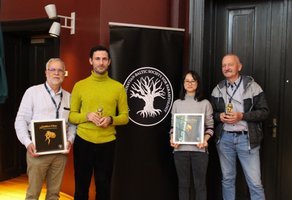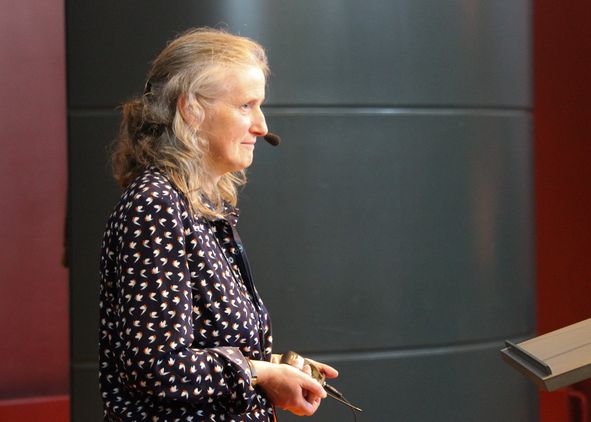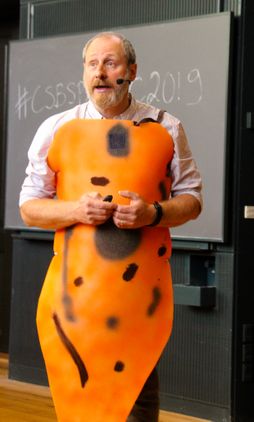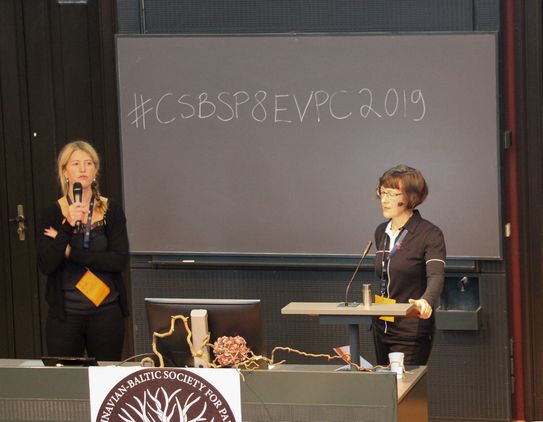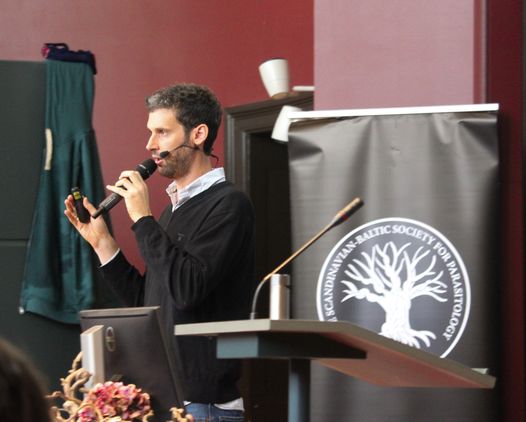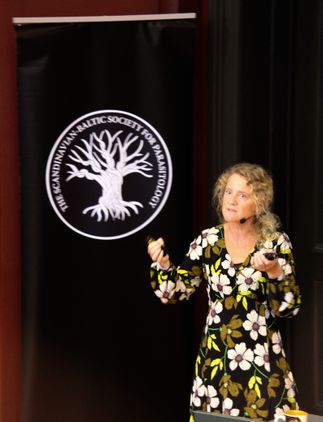PROGRAM
CSBSP8&
EVPC2019
New trends – new challenges
The 8th Conference of
the Scandinavian-Baltic Society for Parasitology (SBSP) and
the Annual Meeting of the European Veterinary Parasitology College (EVPC)
October 10-11, 2019
Copenhagen, Denmark
Workshops and pre-conference activities
Yes! Interesting activities already on the Wednesday!
Social:
We were!
We had a get-together on the Wednesday evening at the venue
and Conference Dinner on the Thursday evening at
Food Space
Slagtehusgade 11, 1715 København
and enjoyed the stormy Copenhagen Culture Night on the Friday!
Sessions:
The program was intense and exciting:
The oral presentations were 10 minutes, including discussion.
Selected posters will be highlighted as short presentations
(1 minute!/1 slide).
Posters:
Posters were shown during the whole event.
Because parasites are beautiful.
Keynotes:
Keynote of the First Session offered something
for everyone’s plate: Foodborne parasites!
Foodborne Parasites – where should we focus our resources?
Grounded in outputs from the COST Action Euro-FBP, the European network for foodborne parasites, Lucy J. Robertson gave a flavour on why parasites remain neglected among the foodborne pathogens, and why we should be concerned.
Moving between human and animal health, while being neither doctor nor veterinarian, gives Prof. Robertson a good One Health perspective. After completion of a BSc. (hons) in Biochemistry at QMC, University of London, and a spell in Sierra Leone teaching parasitology, she moved to Glasgow to take up a PhD investigating interactions between intestinal nematodes and host nutrition, based largely on work conducted among primary schoolchildren in Coclé Province, Panama. Initial postdoc work focused on intestinal protozoan infections, Cryptosporidium and Giardia, at the Scottish Parasite Diagnostic Lab in Stobhill General Hospital, before moving to Norway where she began work at the parasitology laboratory of the Norwegian College of Veterinary Medicine. She now heads the team at the Parasitology Lab of the Faculty of Veterinary Medicine, Norwegian University of Life Sciences, Norway.
Keynote of the Second Session had an intriguing title:
Good teacher and bad students: Leishmania is lecturing.
This learning experience touched upon quick global changes,
new patterns, epidemiology, the role of wildlife, and challenges in the One Health approach. On behalf of Leishmania, it was
Ezio Ferroglio giving this stimulating talk.
Ezio Ferroglio graduated in veterinary medicine in 1992, gained his PhD in ‘Epidemiology and control of zoonosis’ at the University of Bologna in 1997. He is currently Full Professor of Parasitology and Parasitic Diseases at the Department of Veterinary Sciences and Director of the Agriculture and Veterinary Medicine School of the University of Turin, Italy. Since 1999 he has been involved in more than 70 research projects relating to the diagnosis, epidemiology and pathogenesis of parasites of livestock, pets, and honey bees, and on wildlife diseases of public health interest – with a special focus on zoonotic parasites and in particular Leishmania. He became a member of the European Veterinary Parasitology College in September 2003 and the European College of Veterinary Public Health in July 2005.
Keynote of the Fourth Session was all about
horses and parasites!
Control of equine strongyle infections
– the Swedish approach
The “ABBA of equine parasitology” (yes, wow!),
comprising Dr. Eva Osterman Lind and Dr. Eva Tydén,
addressed the spread of anthelmintic resistance and told about the Swedish approach to control of equine strongyle infections.
Eva Osterman Lind works as veterinary officer at SVA (National Veterinary Institute), where she is the head of the parasitology diagnostic laboratory. In 2005 she completed her PhD thesis on prevalence and control of strongyle infections of horses in Sweden. At SVA her interest in horse parasites and selective treatment contributed to the buildup of a monitoring program for horse farms. This represents one of the few examples of largescale programs aimed at reducing the use of anthelmintics. It has also led to a constant improvement and adaption of diagnostic methods.
Eva Tydén is associate professor in molecular pharmacology at the Swedish University of Agricultural Sciences. Her research focus is on understanding molecular mechanism of anthelmintic resistance and sustainable equine parasite control. Her background in molecular biology and a PhD in pharmacology allows her to search for markers of anthelminthic resistance that can be applied in equine parasitology.
Eva and Eva collaborate in research projects on strongyle infections of the horse with focus on control methods that contribute to slow down the spread of anthelmintic resistance. The topics of their ongoing projects are: (1) Strongylus vulgaris: Approaches for non-chemical control and novel diagnostic opportunities and (2) Selective deworming against bloodworm – risk factors and opportunities
Keynote of the Fifth Session was a guided tour
into interesting interactions in the gut:
Interactions between helminth infection
and nutrition on the host gut microbiome
Dr. Andrew R. Williams told about the most intriguing interactions between nutrition and helminth infection on the composition of the host gut microbiome.
Andrew Williams obtained his BSc and PhD at the University of Western Australia, graduating in 2010. He carried out his postdoctoral training in Oxford and Copenhagen, and was appointed Assistant Professor at the University of Copenhagen in 2015, and then became a tenured Associate Professor in the Department of Veterinary and Animal Sciences in 2017. He is head of the ‘Parasites, Immunology and Gut Health’ research group which conducts both basic and applied research into interactions between gastrointestinal parasites and the host immune system, diet and microbiome. He has published more than 60 peer-reviewed articles in the fields of parasitology, immunology and nutrition and currently holds an elite research fellowship from the Danish Research Council.
Keynote of the Sixth Session:
CYSTINET, the European Network on taeniasis/cysticercosis:
an update
Sarah Gabriël gave an overview of the impressive outcomes
of CYSTINET, the European Network on taeniosis/cysticercosis.
S. Gabriël graduated as a veterinarian from Gent University in 1999. She first worked at the Onderstepoort Veterinary Institute in South Africa on anthelmintic resistance in sheep, then she moved to the University of Zambia for five years, conducting research on Schistosoma spp. and foodborne parasites. Subsequently she worked for three years on a cattle ranch in Gabon, and returned to Belgium in 2008 to conduct research at the Institute of Tropical Medicine on foodborne parasitic zoonoses. Since October 2016 she is head of the Laboratory of Foodborne Zoonoses, Department of Veterinary Public Health and Food Safety, Ghent University, Belgium.
THANK YOU TO OUR AWESOME KEYNOTES! WOW!
